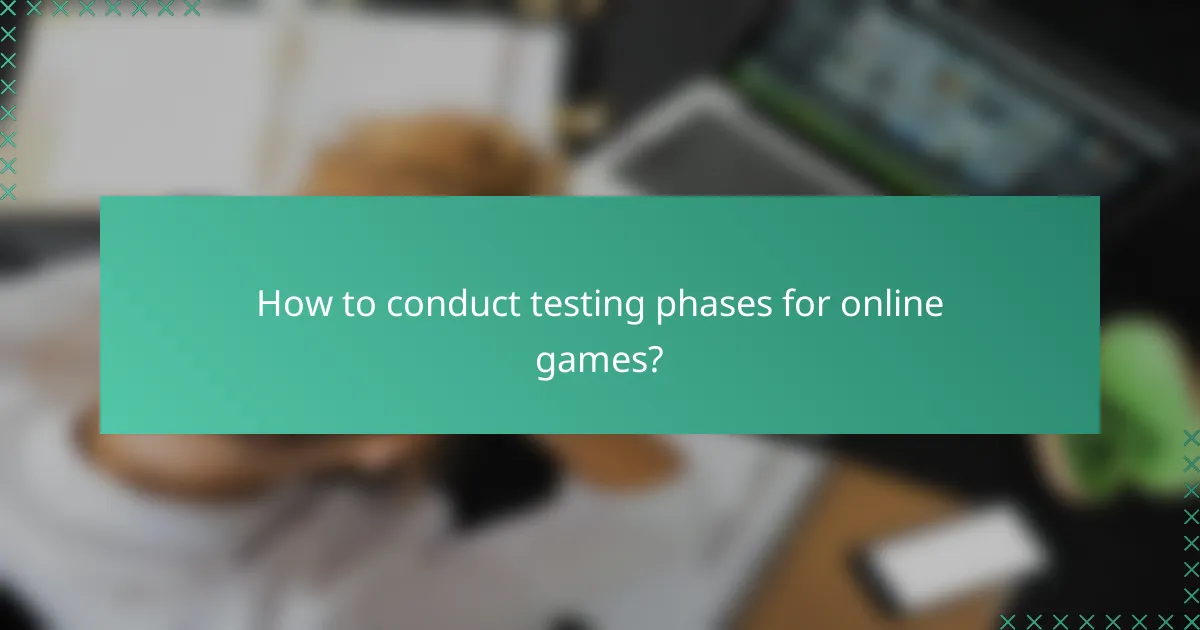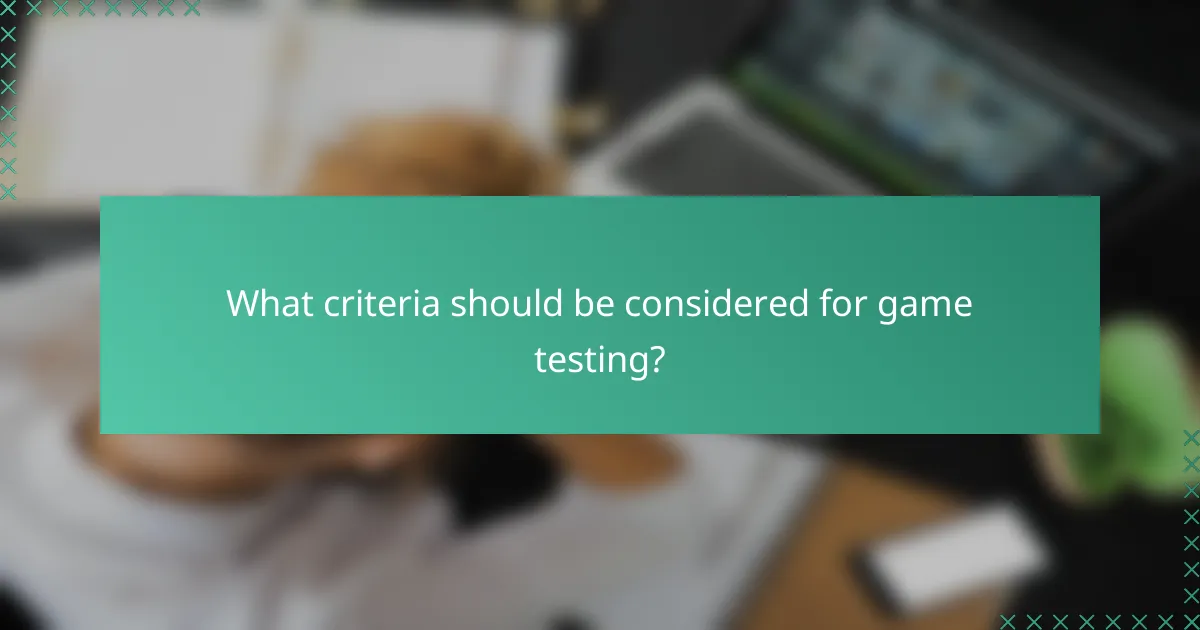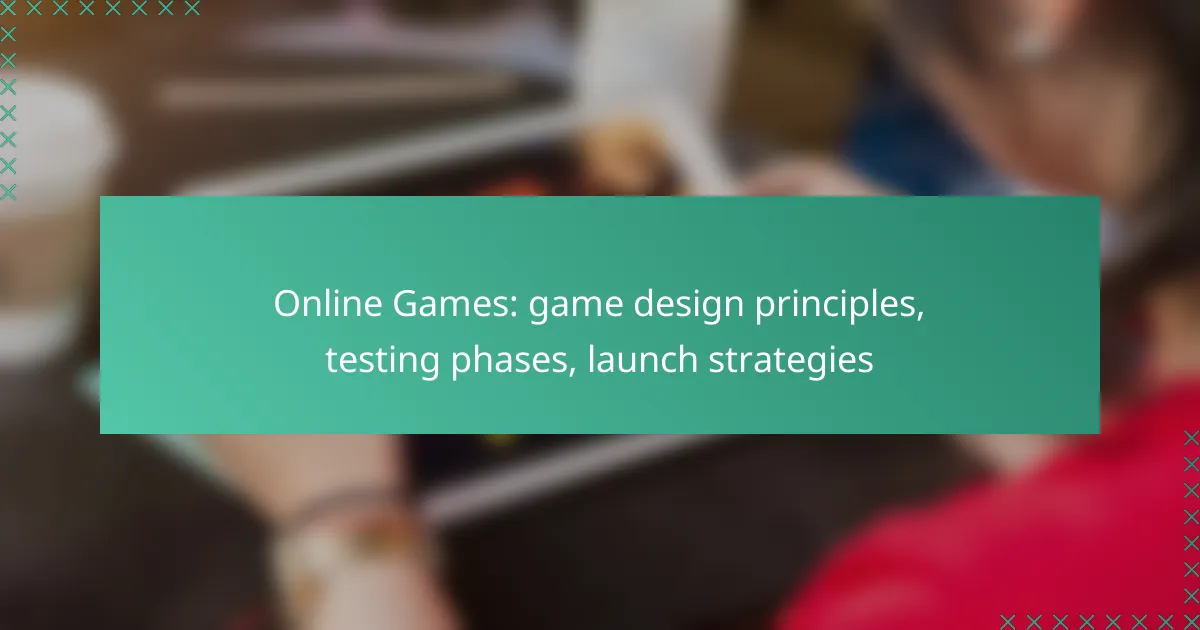Online games require a thoughtful approach to design, focusing on engaging and balanced experiences that captivate players. The development process includes critical testing phases to identify issues and enhance user experience, followed by strategic launch plans to maximize reach and maintain player interest. Understanding these principles is essential for creating successful and enduring online gaming experiences.

What are effective game design principles for online games?
Effective game design principles for online games focus on creating engaging, balanced, and visually appealing experiences that retain players. Key elements include user engagement strategies, difficulty balancing, feedback mechanisms, aesthetics, and monetization models.
User engagement strategies
User engagement strategies are crucial for keeping players interested and invested in the game. Techniques such as incorporating social features, regular updates, and community events can foster a sense of belonging and encourage players to return.
Utilizing rewards systems, like daily login bonuses or achievement unlocks, can motivate players to engage more frequently. Additionally, creating compelling narratives and character development can enhance emotional investment in the game.
Balancing difficulty levels
Balancing difficulty levels is essential to ensure that players remain challenged but not frustrated. Gradually increasing the difficulty as players progress can help maintain interest while preventing burnout.
Implementing adjustable difficulty settings allows players to tailor their experience according to their skill level. Regularly gathering player feedback can also help identify areas where adjustments may be necessary to improve the overall experience.
Feedback mechanisms
Feedback mechanisms provide players with essential information about their performance and the game environment. Clear visual and auditory cues can enhance understanding and satisfaction during gameplay.
Incorporating systems like in-game notifications, progress bars, and performance analytics can help players track their achievements and areas for improvement. Regular updates based on player feedback can also demonstrate responsiveness and foster community trust.
Visual and audio aesthetics
Visual and audio aesthetics significantly impact player immersion and enjoyment. A cohesive art style that aligns with the game’s theme can create a memorable experience, while high-quality sound design enhances emotional engagement.
Consideration of color schemes, character design, and environmental details can elevate the overall appeal. Additionally, using adaptive audio that changes based on player actions can further enrich the gaming experience.
Monetization models
Monetization models determine how a game generates revenue while maintaining player satisfaction. Common approaches include free-to-play with in-game purchases, subscription services, and one-time purchases.
It’s important to strike a balance between profitability and player experience. Avoid aggressive monetization tactics that may alienate users, and consider offering value through cosmetic items or optional expansions to enhance gameplay without compromising fairness.

How to conduct testing phases for online games?
Testing phases for online games are crucial for identifying bugs and ensuring a smooth user experience. These phases typically include alpha testing, beta testing, and usability testing, each serving distinct purposes in the game development lifecycle.
Alpha testing procedures
Alpha testing is the initial phase where the game is tested internally by developers and selected testers. This stage focuses on identifying major bugs and gameplay issues before the game is released to a broader audience.
During alpha testing, developers should create a checklist of critical features to evaluate, such as game mechanics, graphics, and performance. It’s common to conduct multiple rounds of testing, iterating on feedback to refine the game.
Beta testing methods
Beta testing involves releasing the game to a limited external audience to gather feedback on gameplay and performance. This phase helps identify issues that may not have been caught during alpha testing and assesses how the game performs under real-world conditions.
There are two main types of beta testing: closed beta, where access is limited to a select group, and open beta, which is available to anyone interested. Both methods can provide valuable insights, but closed beta allows for more controlled feedback.
Usability testing techniques
Usability testing focuses on how easily players can navigate and enjoy the game. This phase assesses the user interface, controls, and overall player experience to ensure the game is intuitive and engaging.
Common techniques include observation of players as they interact with the game, surveys to gather player opinions, and A/B testing to compare different design elements. It’s essential to analyze this feedback to make necessary adjustments before the final launch.

What are the best launch strategies for online games in Australia?
The best launch strategies for online games in Australia involve a combination of effective pre-launch marketing, well-planned launch events, and robust post-launch support. These strategies ensure that the game reaches its target audience, creates excitement, and maintains player engagement after launch.
Pre-launch marketing tactics
Pre-launch marketing is crucial for generating buzz and building a community around your game. Utilize social media platforms, gaming forums, and influencer partnerships to create anticipation. Consider offering early access or beta testing opportunities to engage potential players and gather valuable feedback.
Effective tactics include creating teaser trailers, engaging in content marketing through blogs, and running targeted ads. Collaborating with local gaming events or conventions in Australia can also enhance visibility and reach a broader audience.
Launch event planning
A well-executed launch event can significantly impact your game’s initial reception. Consider hosting a virtual launch party that includes live gameplay, Q&A sessions, and giveaways. This interactive approach can foster a sense of community and excitement among players.
Timing is essential; choose a date that avoids major holidays or competing game releases. Additionally, ensure that your servers are prepared for the influx of players to avoid technical issues that could tarnish the launch experience.
Post-launch support strategies
Post-launch support is vital for retaining players and addressing any issues that arise. Establish a dedicated support team to handle player inquiries and feedback promptly. Regular updates and patches can help maintain game balance and fix bugs, demonstrating your commitment to the player community.
Consider implementing a feedback loop where players can suggest improvements or report issues. This engagement can enhance player loyalty and encourage a thriving community around your game. Additionally, hosting regular events or updates can keep players interested and returning to the game over time.

What criteria should be considered for game testing?
Game testing should focus on performance, usability, and player feedback to ensure a polished final product. Evaluating these criteria helps identify issues early and enhances the overall gaming experience.
Performance benchmarks
Performance benchmarks are essential for assessing how well a game runs under various conditions. Key metrics include frame rates, load times, and responsiveness, which should ideally remain consistent across different hardware configurations.
For example, a target frame rate of 60 frames per second (fps) is common for smooth gameplay, while load times should generally be under 30 seconds. Testing on a range of devices can help ensure that performance meets player expectations.
Player feedback analysis
Analyzing player feedback is crucial for understanding user experience and satisfaction. Gathering insights through surveys, beta testing, and community forums can reveal areas for improvement and highlight features that resonate with players.
Consider implementing a structured feedback process, such as a rating system or open-ended questions, to capture both quantitative and qualitative data. This information can guide design adjustments and prioritize updates based on player preferences.

How to ensure ongoing player engagement after launch?
To maintain player engagement after launch, focus on delivering fresh content and fostering a vibrant community. Regular updates and active community management are essential to keep players invested in the game.
Content updates
Content updates are crucial for keeping the game experience fresh and exciting. This can include new levels, characters, or game modes that provide players with new challenges and experiences. Aim to release updates regularly, such as monthly or quarterly, to sustain interest.
Consider seasonal events or themed updates that align with holidays or current trends. These limited-time offerings can create urgency and encourage players to return to the game. For example, introducing a Halloween-themed event with exclusive rewards can boost player activity during that period.
Community management
Effective community management helps build a loyal player base. Engage with players through social media, forums, and in-game events to create a sense of belonging. Listening to player feedback and addressing concerns can significantly enhance their experience and satisfaction.
Establishing clear communication channels is vital. Regularly update players on upcoming changes, events, and community highlights. Consider hosting Q&A sessions or live streams to interact directly with your audience, making them feel valued and heard.

What are emerging trends in online game development?
Emerging trends in online game development focus on enhancing player engagement and experience through innovative technologies and design principles. Key trends include the integration of artificial intelligence, the rise of cloud gaming, and the increasing importance of community-driven content.
Integration of AI in gameplay
The integration of AI in gameplay is transforming how players interact with games. AI can create more dynamic and responsive environments, allowing for personalized experiences based on player behavior and preferences.
For instance, AI-driven non-player characters (NPCs) can adapt their strategies in real-time, making gameplay more challenging and engaging. Developers should consider using machine learning algorithms to analyze player data and adjust game difficulty accordingly.
When implementing AI, it’s crucial to balance complexity and performance. Overly complex AI can lead to increased development time and resource consumption, while simpler systems may not provide the desired level of engagement. Aim for a middle ground that enhances gameplay without overwhelming players or developers.
